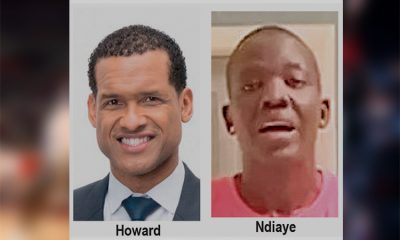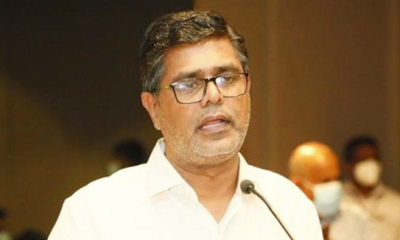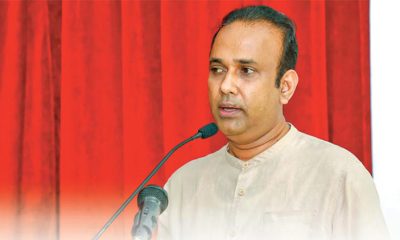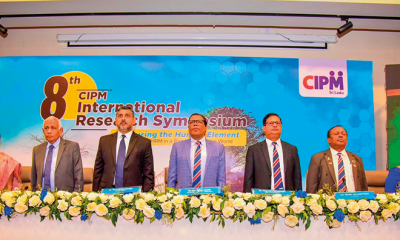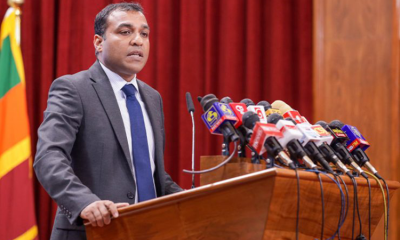Features
Politicians Play Survival Games while People Keep Protesting for Survival
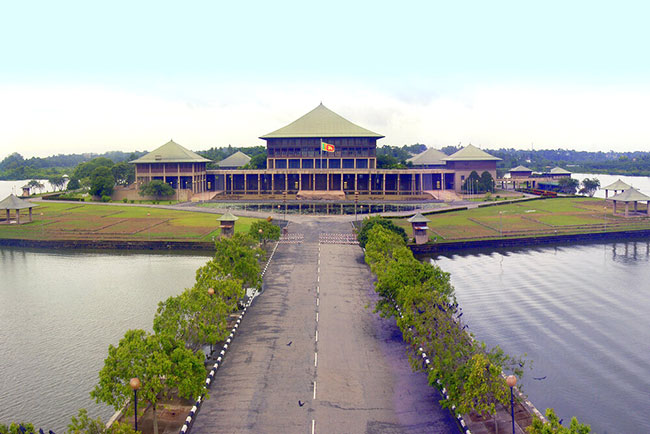
Rajan Philips
There is a massive disconnect between the political protests of the people and the survival games that politicians are playing. The President is playing hide and seek from the people and getting his handful of Ministers to say that their boss is ‘not going to budge.’ The Prime Minister, the family’s only communicator comes on television and cuts a sorry figure as a long-gone has-been. The PM says he is ready to meet with the young protesters, but the young protesters are saying there is nothing to meet about and the only thing the PM can do is go into sunset with the President.
The 11-party dissident alliance in the government is going dizzy as it tries every trick in the book to stay politically relevant and insure their seats in parliament. The shameless Maithripala Sirisena even tried a fast one to become interim PM elbowing out MR. The bulk of the SLPP MPs are rudderless without Basil who is powerless to do anything. The entire government formation, so to speak, has been thoroughly debilitated by the protests. But the government has been able to hold on to its SLPP MPs to maintain a bare minimum but precarious simple majority. The 41 MPs of the 11-party alliance are shuffling for a parking spot in parliament, but they have no connection whatsoever to ongoing politics outside parliament.
The opposition formation is not very much different, except that it is not as decadent as the government. Ranil Wickremesinghe, the lonely UNP leader still pretending to be on his high horse, has been opining that “what Sri Lanka needs today is not a change of government but a change of systems including vast economic reforms to avoid a revolution.” To that end, he is proposing “new legislation for Parliament to take over the finances,” and he is “preparing a set of reforms for this purpose.” Mr. Wickremesinghe went further: “One should understand the situation which prevails today. People who have been led by the youth want a new beginning and a complete change of the systems. Parliament at the moment is focusing on a change of government. Peaceful protests that are going on at the moment will turn into a revolution if we ignore people’s demands.”
Parliament and the People
Mr. Wickremesinghe’s statement is obviously more sophisticated than anything that Rajapaksas can put together. But he slips into sophistry when he says that “focusing on a change of government” is somehow tantamount to turning “a deaf ear to people’s demands.” How so, when the sole demand of the people is for the resignation of the President and the Prime Minister? Mr. Wickremesinghe is not only mute on the matter of resignations, but he is also not explaining how he will legislate “for parliament to take over the finances” while the government and the President who destroyed the financial system continue in office.
At least objectively, the former PM’s scheme would serve the same purpose as the 11-party alliance’s proposal to establish a ‘National Executive Council’ under the incumbent President, or the crazy constitutional amendment bill drafted by Lawyers Romesh de Silva and Manohara de Silva to allow cabinet ministers to be drawn from outside parliament. And that purpose is to find a way to keep the Rajapaksa presidency going while appearing to address the concerns raised by the protesting public. I call these political survival games by or on behalf of politicians whom the people want thrown out lock, stock and barrel.
The JVP is honest about calling for the resignation of the President and refusing to be involved in any interim arrangement that will include the incumbent. However, the JVP has not been able to connect itself, let alone give leadership, to public protests that are now getting into the third week after their start on March 31 in Mirihana. The JVP started by being cautious about the initiators of the protesters and their lack of ‘accountability.’ Later it warmed itself to the protests but has not been able to establish any linkages with them. For a Party and its leader, Anura Kumara Dissanayake, who last year declared that they were ready to give leadership to the country, have been nowhere near-ready to respond to the most spontaneous and sustained public protest that unfolded over the last fortnight.
More to the point of this article, the JVP and its leader have been totally ineffective about doing anything to align the business of parliament with the protests outside. This is quite a setback after AKD’s stellar performance in parliament exposing the innards of the controversial LNG deal with New Fortress Energy (NFE). While individual performances are great for image, you cannot achieve anything substantial in parliament unless you are able to work with others. Especially so for a party like the JVP that has only three MPs. And the JVP has been woefully wanting in striking cross-party alliances in parliament when the people are crossing boundaries to unite in protest against the government. Unless the JVP changes its approach it will lose its relevance despite its self-assured readiness.
In contrast to the JVP and its leader, Sajith Premadasa and the SJB have tried to take to parliament the momentum from outside. Like the JVP, the SJB has also refused to be involved in any interim arrangement unless the President resigns beforehand. But unlike the JVP, Mr. Premadasa has taken symbolic and practical steps such as a No Confidence Motion against the government and the abolition of the Executive Presidency. He has already signed the petition for a No Confidence Motion and the resolution for Impeachment. A bill for ‘abolishing’ the Executive Presidency is apparently in progress. Whether they will succeed or not will depend on how Mr. Premadasa is able to articulate parliament and the people and how he would be able to create voting alliances in parliament.
Options before Parliament
At the same time, the onus of making parliament responsive to the people should not be on a single individual leader. It should be up to every MP to clearly show where she or he stands. Besides the SJB leader and MPs, Gajendrakumar Ponnambalam and his Tamil Congress MPs are also reported to have signed on to the two resolutions. This should double the onus on other Tamil and Muslim MPs. Especially the TNA and especially after its ill-timed meeting with the President after being stood up by him for over two years. Remarkably, while almost all Upcountry Tamil MPs have left the governing SLPP alliance, more than a handful of Northern and Eastern Tamil and Muslim MPs are still reluctant to break ranks with the government.
One would think the three JVP MPs will not shy away from supporting the SJB initiatives in parliament. The same goes for Ranil Wickremesinghe despite his rarefied musings about implementing financial reforms through parliament under the current government and its President. The key to any shifting of MPs and their numbers will be the 41 MPs of the 11-party alliance. They have indicated their non-agreement with the No Confidence Motion approach, but they cannot indefinitely remain non-aligned between the Rajapaksa regime and the Premadasa opposition. If the 41 MPs decide to vote against the government and if all Tamil and Muslim MPs count themselves against the government, then there will be a loosening up of the core SLPP contingent, assuming that there is something core about it.
All of this might enable passing a No Confidence Motion against the government, but launching impeachment proceedings against the President will still be a long shot. On the other hand, a more specific No Confidence Motion could be moved against the President. I alluded to this earlier as a parliamentary initiative. Since then, Dr. Nihal Jayawickrama has pointed out that parliament can, and in the current situation has the obligation to, pass a No Confidence Motion against the President under Article 42 of the Constitution which holds the President “responsible to Parliament for the due exercise, performance and discharge of his powers, duties and functions under the Constitution and any written law including the law for the time being relating to public security”
More than the government, it is the President who deserves a No Confidence Motion against him on account of his abject failure in the management of the economy through ill-chosen Secretaries and Governors, despite all the powers that he granted himself through the 20th Amendment. Even so, a No Confidence Motion can seemingly serve only a symbolic purpose as it cannot compel President Rajapaksa to resign from office. But actions in parliament can and do serve a substantive purpose, that of articulating protest politics with constitutional politics. Together they can bring pressure on the two remaining Rajapaksas to exit gracefully within an agreed upon time period. If parliament fails to act in response to protest politics, parliament itself and not just SLPP MPs will become irrelevant.
Nearly 400 years ago, Oliver Cromwell sacked a corrupt British parliament (the Long Parliament) and scolded away its MPs, “”You have sat too long here for any good you have been doing. Depart, I say, and let us have done with you. In the name of God, go”. Sri Lanka has no Cromwell, but it has its people. They are not going anywhere. Only the President and/or the Parliament will have to go somewhere. The Parliament can go for reelection but not likely until the President goes through his resignation.
Features
The heart-friendly health minister

by Dr Gotabhya Ranasinghe
Senior Consultant Cardiologist
National Hospital Sri Lanka
When we sought a meeting with Hon Dr. Ramesh Pathirana, Minister of Health, he graciously cleared his busy schedule to accommodate us. Renowned for his attentive listening and deep understanding, Minister Pathirana is dedicated to advancing the health sector. His openness and transparency exemplify the qualities of an exemplary politician and minister.
Dr. Palitha Mahipala, the current Health Secretary, demonstrates both commendable enthusiasm and unwavering support. This combination of attributes makes him a highly compatible colleague for the esteemed Minister of Health.
Our discussion centered on a project that has been in the works for the past 30 years, one that no other minister had managed to advance.
Minister Pathirana, however, recognized the project’s significance and its potential to revolutionize care for heart patients.
The project involves the construction of a state-of-the-art facility at the premises of the National Hospital Colombo. The project’s location within the premises of the National Hospital underscores its importance and relevance to the healthcare infrastructure of the nation.
This facility will include a cardiology building and a tertiary care center, equipped with the latest technology to handle and treat all types of heart-related conditions and surgeries.
Securing funding was a major milestone for this initiative. Minister Pathirana successfully obtained approval for a $40 billion loan from the Asian Development Bank. With the funding in place, the foundation stone is scheduled to be laid in September this year, and construction will begin in January 2025.
This project guarantees a consistent and uninterrupted supply of stents and related medications for heart patients. As a result, patients will have timely access to essential medical supplies during their treatment and recovery. By securing these critical resources, the project aims to enhance patient outcomes, minimize treatment delays, and maintain the highest standards of cardiac care.
Upon its fruition, this monumental building will serve as a beacon of hope and healing, symbolizing the unwavering dedication to improving patient outcomes and fostering a healthier society.We anticipate a future marked by significant progress and positive outcomes in Sri Lanka’s cardiovascular treatment landscape within the foreseeable timeframe.
Features
A LOVING TRIBUTE TO JESUIT FR. ALOYSIUS PIERIS ON HIS 90th BIRTHDAY

by Fr. Emmanuel Fernando, OMI
Jesuit Fr. Aloysius Pieris (affectionately called Fr. Aloy) celebrated his 90th birthday on April 9, 2024 and I, as the editor of our Oblate Journal, THE MISSIONARY OBLATE had gone to press by that time. Immediately I decided to publish an article, appreciating the untiring selfless services he continues to offer for inter-Faith dialogue, the renewal of the Catholic Church, his concern for the poor and the suffering Sri Lankan masses and to me, the present writer.
It was in 1988, when I was appointed Director of the Oblate Scholastics at Ampitiya by the then Oblate Provincial Fr. Anselm Silva, that I came to know Fr. Aloy more closely. Knowing well his expertise in matters spiritual, theological, Indological and pastoral, and with the collaborative spirit of my companion-formators, our Oblate Scholastics were sent to Tulana, the Research and Encounter Centre, Kelaniya, of which he is the Founder-Director, for ‘exposure-programmes’ on matters spiritual, biblical, theological and pastoral. Some of these dimensions according to my view and that of my companion-formators, were not available at the National Seminary, Ampitiya.
Ever since that time, our Oblate formators/ accompaniers at the Oblate Scholasticate, Ampitiya , have continued to send our Oblate Scholastics to Tulana Centre for deepening their insights and convictions regarding matters needed to serve the people in today’s context. Fr. Aloy also had tried very enthusiastically with the Oblate team headed by Frs. Oswald Firth and Clement Waidyasekara to begin a Theologate, directed by the Religious Congregations in Sri Lanka, for the contextual formation/ accompaniment of their members. It should very well be a desired goal of the Leaders / Provincials of the Religious Congregations.
Besides being a formator/accompanier at the Oblate Scholasticate, I was entrusted also with the task of editing and publishing our Oblate journal, ‘The Missionary Oblate’. To maintain the quality of the journal I continue to depend on Fr. Aloy for his thought-provoking and stimulating articles on Biblical Spirituality, Biblical Theology and Ecclesiology. I am very grateful to him for his generous assistance. Of late, his writings on renewal of the Church, initiated by Pope St. John XX111 and continued by Pope Francis through the Synodal path, published in our Oblate journal, enable our readers to focus their attention also on the needed renewal in the Catholic Church in Sri Lanka. Fr. Aloy appreciated very much the Synodal path adopted by the Jesuit Pope Francis for the renewal of the Church, rooted very much on prayerful discernment. In my Religious and presbyteral life, Fr.Aloy continues to be my spiritual animator / guide and ongoing formator / acccompanier.
Fr. Aloysius Pieris, BA Hons (Lond), LPh (SHC, India), STL (PFT, Naples), PhD (SLU/VC), ThD (Tilburg), D.Ltt (KU), has been one of the eminent Asian theologians well recognized internationally and one who has lectured and held visiting chairs in many universities both in the West and in the East. Many members of Religious Congregations from Asian countries have benefited from his lectures and guidance in the East Asian Pastoral Institute (EAPI) in Manila, Philippines. He had been a Theologian consulted by the Federation of Asian Bishops’ Conferences for many years. During his professorship at the Gregorian University in Rome, he was called to be a member of a special group of advisers on other religions consulted by Pope Paul VI.
Fr. Aloy is the author of more than 30 books and well over 500 Research Papers. Some of his books and articles have been translated and published in several countries. Among those books, one can find the following: 1) The Genesis of an Asian Theology of Liberation (An Autobiographical Excursus on the Art of Theologising in Asia, 2) An Asian Theology of Liberation, 3) Providential Timeliness of Vatican 11 (a long-overdue halt to a scandalous millennium, 4) Give Vatican 11 a chance, 5) Leadership in the Church, 6) Relishing our faith in working for justice (Themes for study and discussion), 7) A Message meant mainly, not exclusively for Jesuits (Background information necessary for helping Francis renew the Church), 8) Lent in Lanka (Reflections and Resolutions, 9) Love meets wisdom (A Christian Experience of Buddhism, 10) Fire and Water 11) God’s Reign for God’s poor, 12) Our Unhiddden Agenda (How we Jesuits work, pray and form our men). He is also the Editor of two journals, Vagdevi, Journal of Religious Reflection and Dialogue, New Series.
Fr. Aloy has a BA in Pali and Sanskrit from the University of London and a Ph.D in Buddhist Philosophy from the University of Sri Lankan, Vidyodaya Campus. On Nov. 23, 2019, he was awarded the prestigious honorary Doctorate of Literature (D.Litt) by the Chancellor of the University of Kelaniya, the Most Venerable Welamitiyawe Dharmakirthi Sri Kusala Dhamma Thera.
Fr. Aloy continues to be a promoter of Gospel values and virtues. Justice as a constitutive dimension of love and social concern for the downtrodden masses are very much noted in his life and work. He had very much appreciated the commitment of the late Fr. Joseph (Joe) Fernando, the National Director of the Social and Economic Centre (SEDEC) for the poor.
In Sri Lanka, a few religious Congregations – the Good Shepherd Sisters, the Christian Brothers, the Marist Brothers and the Oblates – have invited him to animate their members especially during their Provincial Congresses, Chapters and International Conferences. The mainline Christian Churches also have sought his advice and followed his seminars. I, for one, regret very much, that the Sri Lankan authorities of the Catholic Church –today’s Hierarchy—- have not sought Fr.
Aloy’s expertise for the renewal of the Catholic Church in Sri Lanka and thus have not benefited from the immense store of wisdom and insight that he can offer to our local Church while the Sri Lankan bishops who governed the Catholic church in the immediate aftermath of the Second Vatican Council (Edmund Fernando OMI, Anthony de Saram, Leo Nanayakkara OSB, Frank Marcus Fernando, Paul Perera,) visited him and consulted him on many matters. Among the Tamil Bishops, Bishop Rayappu Joseph was keeping close contact with him and Bishop J. Deogupillai hosted him and his team visiting him after the horrible Black July massacre of Tamils.
Features
A fairy tale, success or debacle

Sri Lanka-Singapore Free Trade Agreement
By Gomi Senadhira
senadhiragomi@gmail.com
“You might tell fairy tales, but the progress of a country cannot be achieved through such narratives. A country cannot be developed by making false promises. The country moved backward because of the electoral promises made by political parties throughout time. We have witnessed that the ultimate result of this is the country becoming bankrupt. Unfortunately, many segments of the population have not come to realize this yet.” – President Ranil Wickremesinghe, 2024 Budget speech
Any Sri Lankan would agree with the above words of President Wickremesinghe on the false promises our politicians and officials make and the fairy tales they narrate which bankrupted this country. So, to understand this, let’s look at one such fairy tale with lots of false promises; Ranil Wickremesinghe’s greatest achievement in the area of international trade and investment promotion during the Yahapalana period, Sri Lanka-Singapore Free Trade Agreement (SLSFTA).
It is appropriate and timely to do it now as Finance Minister Wickremesinghe has just presented to parliament a bill on the National Policy on Economic Transformation which includes the establishment of an Office for International Trade and the Sri Lanka Institute of Economics and International Trade.
Was SLSFTA a “Cleverly negotiated Free Trade Agreement” as stated by the (former) Minister of Development Strategies and International Trade Malik Samarawickrama during the Parliamentary Debate on the SLSFTA in July 2018, or a colossal blunder covered up with lies, false promises, and fairy tales? After SLSFTA was signed there were a number of fairy tales published on this agreement by the Ministry of Development Strategies and International, Institute of Policy Studies, and others.
However, for this article, I would like to limit my comments to the speech by Minister Samarawickrama during the Parliamentary Debate, and the two most important areas in the agreement which were covered up with lies, fairy tales, and false promises, namely: revenue loss for Sri Lanka and Investment from Singapore. On the other important area, “Waste products dumping” I do not want to comment here as I have written extensively on the issue.
1. The revenue loss
During the Parliamentary Debate in July 2018, Minister Samarawickrama stated “…. let me reiterate that this FTA with Singapore has been very cleverly negotiated by us…. The liberalisation programme under this FTA has been carefully designed to have the least impact on domestic industry and revenue collection. We have included all revenue sensitive items in the negative list of items which will not be subject to removal of tariff. Therefore, 97.8% revenue from Customs duty is protected. Our tariff liberalisation will take place over a period of 12-15 years! In fact, the revenue earned through tariffs on goods imported from Singapore last year was Rs. 35 billion.
The revenue loss for over the next 15 years due to the FTA is only Rs. 733 million– which when annualised, on average, is just Rs. 51 million. That is just 0.14% per year! So anyone who claims the Singapore FTA causes revenue loss to the Government cannot do basic arithmetic! Mr. Speaker, in conclusion, I call on my fellow members of this House – don’t mislead the public with baseless criticism that is not grounded in facts. Don’t look at petty politics and use these issues for your own political survival.”
I was surprised to read the minister’s speech because an article published in January 2018 in “The Straits Times“, based on information released by the Singaporean Negotiators stated, “…. With the FTA, tariff savings for Singapore exports are estimated to hit $10 million annually“.
As the annual tariff savings (that is the revenue loss for Sri Lanka) calculated by the Singaporean Negotiators, Singaporean $ 10 million (Sri Lankan rupees 1,200 million in 2018) was way above the rupees’ 733 million revenue loss for 15 years estimated by the Sri Lankan negotiators, it was clear to any observer that one of the parties to the agreement had not done the basic arithmetic!
Six years later, according to a report published by “The Morning” newspaper, speaking at the Committee on Public Finance (COPF) on 7th May 2024, Mr Samarawickrama’s chief trade negotiator K.J. Weerasinghehad had admitted “…. that forecasted revenue loss for the Government of Sri Lanka through the Singapore FTA is Rs. 450 million in 2023 and Rs. 1.3 billion in 2024.”
If these numbers are correct, as tariff liberalisation under the SLSFTA has just started, we will pass Rs 2 billion very soon. Then, the question is how Sri Lanka’s trade negotiators made such a colossal blunder. Didn’t they do their basic arithmetic? If they didn’t know how to do basic arithmetic they should have at least done their basic readings. For example, the headline of the article published in The Straits Times in January 2018 was “Singapore, Sri Lanka sign FTA, annual savings of $10m expected”.
Anyway, as Sri Lanka’s chief negotiator reiterated at the COPF meeting that “…. since 99% of the tariffs in Singapore have zero rates of duty, Sri Lanka has agreed on 80% tariff liberalisation over a period of 15 years while expecting Singapore investments to address the imbalance in trade,” let’s turn towards investment.
Investment from Singapore
In July 2018, speaking during the Parliamentary Debate on the FTA this is what Minister Malik Samarawickrama stated on investment from Singapore, “Already, thanks to this FTA, in just the past two-and-a-half months since the agreement came into effect we have received a proposal from Singapore for investment amounting to $ 14.8 billion in an oil refinery for export of petroleum products. In addition, we have proposals for a steel manufacturing plant for exports ($ 1 billion investment), flour milling plant ($ 50 million), sugar refinery ($ 200 million). This adds up to more than $ 16.05 billion in the pipeline on these projects alone.
And all of these projects will create thousands of more jobs for our people. In principle approval has already been granted by the BOI and the investors are awaiting the release of land the environmental approvals to commence the project.
I request the Opposition and those with vested interests to change their narrow-minded thinking and join us to develop our country. We must always look at what is best for the whole community, not just the few who may oppose. We owe it to our people to courageously take decisions that will change their lives for the better.”
According to the media report I quoted earlier, speaking at the Committee on Public Finance (COPF) Chief Negotiator Weerasinghe has admitted that Sri Lanka was not happy with overall Singapore investments that have come in the past few years in return for the trade liberalisation under the Singapore-Sri Lanka Free Trade Agreement. He has added that between 2021 and 2023 the total investment from Singapore had been around $162 million!
What happened to those projects worth $16 billion negotiated, thanks to the SLSFTA, in just the two-and-a-half months after the agreement came into effect and approved by the BOI? I do not know about the steel manufacturing plant for exports ($ 1 billion investment), flour milling plant ($ 50 million) and sugar refinery ($ 200 million).
However, story of the multibillion-dollar investment in the Petroleum Refinery unfolded in a manner that would qualify it as the best fairy tale with false promises presented by our politicians and the officials, prior to 2019 elections.
Though many Sri Lankans got to know, through the media which repeatedly highlighted a plethora of issues surrounding the project and the questionable credentials of the Singaporean investor, the construction work on the Mirrijiwela Oil Refinery along with the cement factory began on the24th of March 2019 with a bang and Minister Ranil Wickremesinghe and his ministers along with the foreign and local dignitaries laid the foundation stones.
That was few months before the 2019 Presidential elections. Inaugurating the construction work Prime Minister Ranil Wickremesinghe said the projects will create thousands of job opportunities in the area and surrounding districts.
The oil refinery, which was to be built over 200 acres of land, with the capacity to refine 200,000 barrels of crude oil per day, was to generate US$7 billion of exports and create 1,500 direct and 3,000 indirect jobs. The construction of the refinery was to be completed in 44 months. Four years later, in August 2023 the Cabinet of Ministers approved the proposal presented by President Ranil Wickremesinghe to cancel the agreement with the investors of the refinery as the project has not been implemented! Can they explain to the country how much money was wasted to produce that fairy tale?
It is obvious that the President, ministers, and officials had made huge blunders and had deliberately misled the public and the parliament on the revenue loss and potential investment from SLSFTA with fairy tales and false promises.
As the president himself said, a country cannot be developed by making false promises or with fairy tales and these false promises and fairy tales had bankrupted the country. “Unfortunately, many segments of the population have not come to realize this yet”.
(The writer, a specialist and an activist on trade and development issues . )


